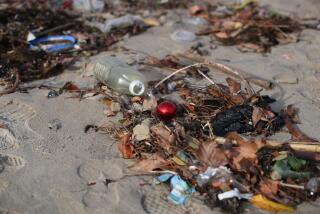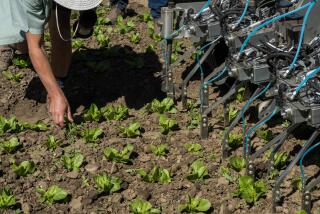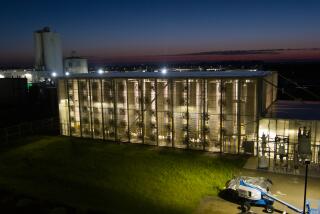Fleet of robots designed to clean up oil
Want to clean up an oil spill? There’s a robot for that.
A team of scientists at MIT have developed a fleet of oil-absorbing robots — Seaswarm — that clean the ocean by collecting oil with a super-absorbent “nanofabric.”
First tested in the Charles River in Boston in August, the box-shaped robots are able to stay in water for long periods without making repeated trips back to shore because they function independently, communicating with one another through global positioning systems and wireless communications.
Measuring 16 feet long and 7 feet wide, a Seaswarm robot is smaller than most commercial skimmers, making it able to travel into hard-to-reach places, such as estuaries. The MIT-patented nanofabric — that is, a fabric enhanced by nanotechnology — is an interwoven mesh of extremely tiny wires made of potassium manganese oxide that can absorb 20 times its weight in oil.
A conveyor belt made of the nanofabric propels the robots forward, allowing them to clean continuously — possibly for weeks at a time. The robots run on solar energy and require only 100 watts of power, the equivalent to one strong light bulb.
Carlo Ratti, director of MIT’s Senseable City Laboratory, led a team of researchers on the project, which was started this year. He talked with The Times about the robots, how they were created, his team and future oil spills.
Describe the robots. How do they work?
Seaswarm receives energy from a series of photovoltaic cells on the “head” of the vehicle and uses swarm technology to coordinate its position on the water, making the operation of these vehicles completely autonomous. The nanofabric-covered conveyor belt works like a paper towel to selectively suck up oil from surface spills, and this oil can then be removed, so the nanofabric can be continuously reused.
Where did the idea for this project come from? How long have you been working on these robots?
Actually, it was a random thing. Of course, we were all concerned about the oil spill [in the Gulf of Mexico]. But we got a request from the Venice Biennale in Italy [a contemporary art and architecture exhibition] to explore how the use of nanotechnology would change people’s lives in the year 2050.
They asked us to work with [MIT visiting professor of Materials Science and Engineering] Francesco Stellacci and a nanofabric he had helped develop. We looked at how this absorbent material could capture oil, and it all started from there.
Can you talk about the scientists and engineers on your team?
To address today’s problems, you really need an interdisciplinary team. From ocean engineers to physicists to product designers, we had a team that came at the project from all angles.
When will the robots be ready for use?
They need quite a bit more work. We keep developing prototype after prototype. By the end of the year, we’ll be in good shape with a working model.
Any chance that these robots could aid in the gulf disaster?
It’s too late for the gulf disaster. Our vehicles are intended to be used on surface oil spills. [Much of the oil in the gulf is underwater.] I guess they will be more useful in a next spill. We all want no more spills, but there are smaller spills all the time.
Just to get a frame of reference, how many of these robots would it have taken to clean up the gulf oil spill?
About 10,000 would be needed.
And how long would it have taken with 10,000?
Approximately one month.
Can the oil that the robots absorb be reused?
There are two possibilities. One possibility is, you can burn the oil. So you clean the sea, but also burn the oil. The other design is that the oil would be sealed into bags that could float in the ocean for a temporary amount of time. So imagine floating reservoirs with GPS, where larger ships could come pick up the oil.
Your robots employ GPS and WiFi. How are these used to make the robots work?
You want to know where they are, and they need to communicate with each other. They need to operate as a swarm. The GPS and WiFi enable the swarm.
Do you envision more disaster reversal robots like this in our future?
Technology, for the first time, is letting us clean up some of the pollution left behind over the last century. I’m not sure [all the solutions] will be robots. But certainly we’ll be more proficient at reversing damage in the future.
What other projects similar to this one are being worked on at MIT?
Last year, we did a project in Seattle called Trash Track. We attached small tags to millions of pieces of trash, so we could better understand the chain of processing trash. Some of the results were a big surprise to us, such as the distance a single piece of trash actually travels.
lori.kozlowski@latimes.com






